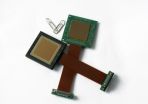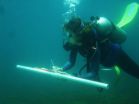(Press-News.org) SEATTLE – Super-sized electromagnetic coils are helping explain how aquatic life might be affected by renewable energy devices being considered for placement along America's coastal waters and in the nation's rivers.
Scientists with the Department of Energy's Pacific Northwest National Laboratory are examining whether a variety of fish and invertebrates change their behavior during and after exposure to an electromagnetic field similar to those produced by marine and hydrokinetic power devices that capture energy from ocean waves, tides, currents and rivers. Research began this summer and will continue for two years.
PNNL marine ecologist Jeff Ward will discuss this research Wednesday at Oceans 2010, an ocean engineering conference that runs Monday through Thursday in Seattle. The conference is being hosted by the Marine Technology Society and the Institute of Electrical and Electronic Engineers' Oceanic Engineering Society.
"The ocean's natural ebb and flow can be an abundant, constant energy source," said PNNL oceanographer Andrea Copping, who is the principal investigator on the project out of PNNL's Marine Sciences Laboratory in Sequim, Wash. "But before we can place power devices in the water, we need to know how they might impact the marine environment."
Energy companies and utilities are looking at using several different technologies to harness energy from oceans and rivers. Marine power could come from devices that move with rolling waves on the ocean's surface or from underwater turbines that spin with the tides and currents. And hydrokinetic devices would be similar to marine power devices, but generate power from free-flowing water in rivers and streams. Whatever the design, each device generates electricity that travels through cables that connect the device with a land power line. Researchers want to know how the devices and their cables affect marine life.
Electrical magnetism
This research project is using two specially designed coils at PNNL's Marine Sciences Laboratory. The coils, called Helmholtz coils, each consist of about 200 pounds of copper wiring wrapped into a window frame-like outline that's roughly five feet by five feet. The wiring carries electricity at the flip of a switch. Like any electricity, this creates an electromagnetic field that naturally attracts magnetic materials like iron. The field around the electrical coil can create between 0.1 and 3 milliTeslas of magnetic flux. Three milliTeslas is about three-tenths the magnetic flux of a typical small bar magnet. Previous research into how electromagnetic fields affect marine animals has been in the 3 to 5 milliTesla range.
Researchers want to know if the electromagnetic field will also affect marine and estuarine animal behavior, including migration, finding food and avoiding predators. Several aquatic animals – such as sharks, skates, salmon, sea turtles and lobsters - may use the Earth's natural magnetic fields like a compass to navigate and detect their prey.
To test the field's potential effects, aquarium tanks filled with marine species are being placed near the two coils. Then researchers will activate the electromagnetic field – at various strengths and time periods – to see if the animals' actions change.
For example, researchers will observe whether the electromagnetic field interferes with the ability of juvenile Coho salmon to recognize and avoid predators. Young salmon normally stop swimming, go low and stay still when they detect a predator. Also, the scientists will examine whether the typically fast, flicking movements of Dungeness crab antennules – the small antennae next to crabs' eyes that help them detect odors – change when exposed to the electromagnetic field. And researchers will document whether the animals are attracted or repelled by the fields.
"We really don't know if the animals will be affected or not," Ward said. "There's surprisingly little comprehensive research to say for sure."
New frontiers
There have been some limited studies in this area, but most have been conducted outside the United States and involved animals that aren't common in U.S. waters. Ward noted this project will help develop a broader body of information from which scientists, marine power developers and the regulatory agencies that permit the power devices can draw to determine how proposed devices could affect certain marine life at a given site.
If animals demonstrate a noticeable behavior change in the controlled environment of laboratory tests, PNNL researchers may conduct a field study with test animals placed near pilot marine power devices such as the one Snohomish County PUD has proposed for Admiralty Inlet in Washington state's Puget Sound.
As part of the project, scientists at Oak Ridge National Laboratory are also examining how electromagnetic fields created by hydrokinetic devices, which generate power from free-flowing water in rivers and streams, might affect freshwater animals. And researchers from Northwest National Marine Renewable Energy Center at Oregon State University are also studying the potential electromagnetic effects on crabs.
This study is a component of PNNL's larger research effort to better understand the potential environmental impact of marine and hydrokinetic energy development. PNNL researchers are also examining whether underwater noise from these devices could impact aquatic life, whether underwater animals could be injured by the rotating turbines in tidal power devices and how marine devices could impact the flow patterns of coastal waters. All this work is being funded by DOE's Office of Energy Efficiency & Renewable Energy, Wind and Water Power Program.
INFORMATION:
Ward will discuss this research during a marine renewable energy session at Oceans 2010. The session runs from 8:30 to 10 a.m. Wednesday in room 4C3 at the Washington State Convention and Trade Center in Seattle. For more information about Oceans 2010, go to http://www.oceans10mtsieeeseattle.org/. Credentialed reporters can receive a free one-day registration at the conference.
REFERENCE: J. Ward, I. Schultz, D. Woodruff, G. Roesijadi, A. Copping. "Assessing the Effects of Marine and Hydrokinetic Energy Development on Marine and Estuarine Resources." Oceans 2010. Copy available upon request.
Pacific Northwest National Laboratory is a Department of Energy Office of Science national laboratory where interdisciplinary teams advance science and technology and deliver solutions to America's most intractable problems in energy, the environment and national security. PNNL employs 4,700 staff, has an annual budget of nearly $1.1 billion, and has been managed by Ohio-based Battelle since the lab's inception in 1965. Follow PNNL on Facebook, LinkedIn and Twitter.
Magnetic attraction for fish, crabs?
Study examines if magnetic fields from aquatic power sources affect animals
2010-09-20
ELSE PRESS RELEASES FROM THIS DATE:
Female fish abandoned by males to raise offspring on their own
2010-09-20
Caring for children can be a tough job, particularly if you are a female cichlid fish.
Native to the crater lakes of Nicaragua, cichlid fish look after their young by defending them against would-be predators. While male and female cichlid fish generally share parental responsibilities, research shows that this is not always the case.
Conducted by an international team of researchers that included two biologists from Monash University, and published in the journal Behavioral Ecology and Sociobiology, new research has shown that male cichlid fish have a propensity ...
Secrets of birds' sexual signals revealed
2010-09-20
Patterned feathers, previously thought to be used only for camouflage in birds, can play an important role in attracting a mate and fending off rivals, a University of Melbourne study reveals.
Ms Thanh-Lan Gluckman, co-author of the paper and Masters of Philosophy student from the Department of Zoology at the University of Melbourne, Australia, said this finding brought a new perspective to research in animal communication and evolution.
"The implication of this study is that feathers don't need to be bright and showy to be used in sexual signalling and hence this changes ...
Protein behind development of immune system sentinels identified
2010-09-20
A protein called PU.1 is essential for the development of dendritic cells, the sentinels of the immune system, Walter and Eliza Hall Institute researchers in Melbourne, Australia, have shown.
Dendritic cells (DC) are immune cells that present proteins from foreign invaders, such as viruses, to the killer T cells of the immune system, allowing a full immune response to be mounted against the invaders.
Researchers from the Immunology division have been studying dendritic cells and how different molecules regulate their development.
Dr Li Wu said one of the molecules ...
Citizen scientist
2010-09-20
We are all scientists now, thanks to SETI@home, Galaxy Zoo, The Great Sunflower Project, Folding@home and counltess other projects that allow individuals to take part in scientific research directly or indirectly. In the case of SETI@home and Folding@home one shares one's computer CPU with the researchers, whereas Galaxy Zoo is more about active involvement with the classification of stellar objects in images of the night sky, for instance.
Now, writing in the International Journal of Organisational Design and Engineering, US researchers have mapped out an approach to ...
Marine scientists unveil the mystery of life on undersea mountains
2010-09-20
They challenge the mountain ranges of the Alps, the Andes and the Himalayas in size yet surprisingly little is known about seamounts, the vast mountains hidden under the world's oceans. Now in a special issue of Marine Ecology scientists uncover the mystery of life on these submerged mountain ranges and reveal why these under studied ecosystems are under threat.
The bathymetry of our oceans is now resolved at a scale and detail unimaginable by early pioneers and recent estimates suggest that, globally, there may be up to 100,000 seamounts, yet despite best efforts less ...
Study gets measure of how best to prevent blood clots
2010-09-20
Treating hospital patients with thigh-length surgical stockings, rather than knee-high socks, can reduce life threatening blood clots, a new study suggests.
Researchers found that knee-high stockings, which are similar to flight socks, do little in stroke patients to prevent deep vein thrombosis (DVT), a life threatening form of blood clot that can travel up into the heart and lungs, .
The CLOTS (Clots in Legs Or sTockings after Stroke) study from the University of Edinburgh highlights that the clot rate in stroke patients was higher among those fitted with the shorter ...
The Amazon rainforest -- a cloud factory
2010-09-20
The forest in the Amazon Basin produces its own rain. During the wet season, aerosol particles, which serve to condensate clouds and precipitation here, mainly consist of organic material. These aerosols are released by the rainforest itself. This has been demonstrated by scientists from the Max Planck Institute for Chemistry in Mainz, who are now able to draw conclusions about the mechanisms of this ecosystem: the high content of organic material indicates that the Amazon Basin acts as a largely self-contained biogeochemical reactor during the rainy season. The results ...
Vigilant camera eye
2010-09-20
»Goal, goal, goal!« fans in the stadium are absolutely ecstatic, the uproar is enormous. So it's hardly surprising that the security personnel fail to spot a brawl going on between a few spectators. Separating jubilant fans from scuffling hooligans is virtually impossible in such a situation. Special surveillance cameras that immediately spot anything untoward and identify anything out of the ordinary could provide a solution. Researchers from the Fraunhofer Institute for Applied Information Technology FIT in Sankt Augustin have now developed such a device as part of the ...
Image sensors for extreme temperatures
2010-09-20
More and more car manufacturers are equipping their vehicles with image sensors – e.g. to register the presence of pedestrians or vehicles in the blind spot or to detect obstacles when parking. The sensors must be able to function in extremely high temperatures and in blazing sunlight. If they are installed behind the rear view mirror or on the instrument panel, for example, they can get very hot. The Fraunhofer Institute for Microelectronic Circuits and Systems IMS in Duisburg has developed a CMOS (complementary metal oxide semiconductor) image sensor for an industrial ...
Taking the pulse of coral reefs
2010-09-20
Healthy reefs with more corals and fish generate predictably greater levels of noise, according to researchers working in Panama. This has important implications for understanding the behaviour of young fish, and provides an exciting new approach for monitoring environmental health by listening to reefs.
Contrary to Jacques Cousteau's 'Silent World', coral reefs are surprisingly noisy places, with fish and invertebrates producing clicks and grunts which combine to produce cacophonies of noise. Each reef is subtly different depending on the size and composition of the ...
LAST 30 PRESS RELEASES:
Why nail-biting, procrastination and other self-sabotaging behaviors are rooted in survival instincts
Regional variations in mechanical properties of porcine leptomeninges
Artificial empathy in therapy and healthcare: advancements in interpersonal interaction technologies
Why some brains switch gears more efficiently than others
UVA’s Jundong Li wins ICDM’S 2025 Tao Li Award for data mining, machine learning
UVA’s low-power, high-performance computer power player Mircea Stan earns National Academy of Inventors fellowship
Not playing by the rules: USU researcher explores filamentous algae dynamics in rivers
Do our body clocks influence our risk of dementia?
Anthropologists offer new evidence of bipedalism in long-debated fossil discovery
Safer receipt paper from wood
Dosage-sensitive genes suggest no whole-genome duplications in ancestral angiosperm
First ancient human herpesvirus genomes document their deep history with humans
Why Some Bacteria Survive Antibiotics and How to Stop Them - New study reveals that bacteria can survive antibiotic treatment through two fundamentally different “shutdown modes”
UCLA study links scar healing to dangerous placenta condition
CHANGE-seq-BE finds off-target changes in the genome from base editors
The Journal of Nuclear Medicine Ahead-of-Print Tip Sheet: January 2, 2026
Delayed or absent first dose of measles, mumps, and rubella vaccination
Trends in US preterm birth rates by household income and race and ethnicity
Study identifies potential biomarker linked to progression and brain inflammation in multiple sclerosis
Many mothers in Norway do not show up for postnatal check-ups
Researchers want to find out why quick clay is so unstable
Superradiant spins show teamwork at the quantum scale
Cleveland Clinic Research links tumor bacteria to immunotherapy resistance in head and neck cancer
First Editorial of 2026: Resisting AI slop
Joint ground- and space-based observations reveal Saturn-mass rogue planet
Inheritable genetic variant offers protection against blood cancer risk and progression
Pigs settled Pacific islands alongside early human voyagers
A Coral reef’s daily pulse reshapes microbes in surrounding waters
EAST Tokamak experiments exceed plasma density limit, offering new approach to fusion ignition
Groundbreaking discovery reveals Africa’s oldest cremation pyre and complex ritual practices
[Press-News.org] Magnetic attraction for fish, crabs?Study examines if magnetic fields from aquatic power sources affect animals







